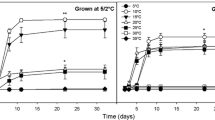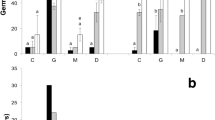Abstract
Understanding the potential for ornamental plant species to become naturalized in a nonnative habitat requires information on seed germination in order to help predict responses of the species to the natural environmental conditions of its new habitat. Cardiocrinum giganteum var. giganteum, which is native to the Himalayas, has been introduced as an ornamental plant in temperate regions of the world, and was categorized recently as invasive in New Zealand. Seed germination requirements of the species were determined under natural conditions in Hokkaido, Japan, to assess its potential to become naturalized in this region of Japan. Mature seeds were collected from its native range in the Indian Himalayas. At maturity in autumn, seeds had underdeveloped embryos, which grew in the second autumn and winter after exposure to summer temperatures. Radicles and cotyledons emerged in late winter and spring. Thus, an 18–19 month period was required from dispersal to seed germination. Under laboratory conditions, this period could be shortened to 10–11 months in a 25/15 °C (120 days) → 15/5 °C (90 days) → 0 °C (90 days) → 15/5 °C (60 days) temperature sequence. GA3 did not substitute for the above temperature requirements. These temperature requirements for seed germination of C. giganteum var. giganteum are very similar to those of its native Japanese congener C. cordatum var. glehnii. Seeds of both taxa have deep simple morphophysiological dormancy. The close similarity in the requirements for regeneration from seeds of the two taxa suggests that the seed stage of the life cycle is not an impediment to the naturalization of the giant Himalayan lily in northern Japan.









Similar content being viewed by others
References
Alpert P, Bone E, Holzapfel C (2000) Invasiveness, invisibility and the role of environmental stress in the spread of nonnative plants. Perspect Plant Ecol Evol Syst 3:52–66
Baskin JM, Baskin CC (1989) Seed germination ecophysiology of Jeffersonia diphylla, a perennial herb of mesic deciduous forests. Am J Bot 76:1073–1080
Baskin CC, Baskin JM (1998) Seeds: ecology, biogeography, and evolution of dormancy and germination. Academic, San Diego
Baskin JM, Baskin CC (2004) A classification system for seed dormancy. Seed Sci Res 14:1–16
Baskin CC, Chien CT, Chen SY, Baskin JM (2008) Germination of Viburnum odoratissimum seeds: a new level of morphophysiological dormancy. Seed Sci Res 18:179–184
Callaway JC, Josselyn MN (1992) The introduction and spread of smooth cordgrass (Spartina alterniflora) in south San Francisco bay. Estuaries 15:218–225
Daehler CC, Carino DA (2000) Predicting invasive plants: prospects for a general screening system based on current regional models. Biol Invasions 2:92–103
di Castri F (1989) History of biological invasions with special emphasis on the Old World. In: Drake JA, Mooney HA, di Castri F, Groves RH, Kruger FJ, Rejmanek M, Williamson M (eds) Biological invasions: a global perspective. Wiley, New York, pp 1–30
Dreyer GD, Baird LM, Fickler C (1987) Celastrus scandens and Celastrus orbiculatus: comparisons of reproductive potential between a native and an introduced woody vine. Bull Torrey Bot Club 114:260–264
Fox D (1985) Growing lilies. Groom Helm, Sydney
Gaur RD (1999) Flora of the district Garhwal North West Himalaya (with ethnobotanical notes). TransMedia, Srinagar-Garhwal
Genders R (1994) Scented flora of the World. Hale, London
Goergen E, Daehler CC (2001) Reproductive ecology of a native Hawaiian grass (Heteropogon contortus; Poaceae) versus its invasive alien competitor (Pennisetum setaceum; Poaceae). Int J Plant Sci 162:317–326
Heywood VH (1989) Patterns, extents and modes of invasions by terrestrial plants. In: Drake JA, Mooney HA, di Castri F, Groves RH, Kruger FJ, Rejmanek M, Williamson M (eds) Biological invasions: a global perspective. Wiley, New York, pp 31–60
Honig MA, Cowling RM, Richardson DM (1992) The invasive potential of Australian banksias in South African fynbos: a comparison of the reproductive potential of Banksia ericifolia and Leucadendron laureolum. Aust J Ecol 17:305–314
Howell CJ, Sawyer JWD (2006) New Zealand naturalized vascular plant checklist. New Zealand Plant Conservation Network, Wellington
Huenneke LF, Vitousek PM (1990) Seedling and clonal recruitment of the invasive tree Psidium cattleianum: implications for management of native Hawaiian forests. Biol Conserv 53:199–211
Huxley A (1992) The new RHS dictionary of gardening. MacMillan, London
India Meteorological Department (2011) Climatological data of important cities: monthly mean maximum and minimum temperatures and total rainfall based upon 1901–2000 data. Ministry of Earth Science, Government of India. http://www.imd.gov.in/doc/climateimp.pdf. Accessed 4 June 2011
Japan Metrological Agency (2011) Climate statistics: normals (1981–2010) (in English). http://www.data.jma.go.jp/obd/stats/data/en/normal/normal.html. Accessed 4 June 2011
Kondo T, Okubo N, Miura T, Honda K, Ishikawa Y (2002) Ecophysiology of seed germination in Erythronium japonicum (Liliaceae) with underdeveloped embryos. Am J Bot 89:1779–1784
Kondo T, Miura T, Okubo N, Shimada M, Baskin C, Baskin J (2004) Ecophysiology of deep simple epicotyl morphophysiological dormancy in seeds of Gagea lutea (Liliaceae). Seed Sci Res 14:371–378
Kondo T, Okubo N, Miura T, Baskin CC, Baskin JM (2005) Ecophysiology of seed dormancy and germination in the mesic woodland herbaceous perennial Corydalis ambigua (Fumariaceae) in Japan. Can J Bot 83:571–578
Kondo T, Sato C, Baskin JM, Baskin CC (2006) Post-dispersal embryo development, germination phenology, and seed dormancy in Cardiocrinum cordatum var. glehnii (Liliaceae s. str.), a perennial herb of the broadleaved deciduous forest in Japan. Am J Bot 93:849–859
Lacey S (1991) Scent in your garden. Little Brown, Boston
Levine JM, Adler PB, Yelenik SG (2004) A meta-analysis of biotic resistance to exotic plant invasions. Ecol Lett 7:975–989
Mahon DJ (2007) Canterbury naturalized vascular plant checklist. Canterbury Conservancy Department of Conservation, Christchurch
Masuda M, Washitani I (1990) A comparative ecology of the seasonal schedules for reproduction by seeds in a moist tall grassland community. Funct Ecol 4:169–182
Milbau A, Stout JC (2008) Factors associated with alien plants transitioning from casual, to naturalized, to invasive. Conserv Biol 22:308–317
Morris LL, Walck JL, Hidayati SN (2002) Growth and reproduction of the invasive Ligustrum sinense and native Forestiera ligustrina (Oleaceae): implications for the invasion and persistence of a nonnative shrub. Int J Plant Sci 163:1001–1010
Nikolaeva MG (1977) Factors controlling the seed dormancy pattern. In: Khan AA (ed) The physiology and biochemistry of seed dormancy and germination. North-Holland, Amsterdam, pp 51–74
Oldfield S (1989) Bulb propagation and trade study. Phase II. Wildlife Trade Monitoring Unit, World Conservation Monitoring Centre, Cambridge. http://www.archive.org/details/bulbpropagationt89oldf. Accessed 24 Feb 2011
Patterson TB, Givnish TJ (2002) Phylogeny, concerted convergence, and phylogenetic niche conservationism in the core Liliales: insights from rbcL and ndhF sequence data. Evolution 56:233–252
Perrings C, Williamson M, Barbier EB, Delfino D, Dalmazzone S, Shogren J, Simmons P, Watkinson A (2002) Biological invasion risks and the public good: an economic perspective. Conserv Ecol 6:1. (online). http://www.consecol.org/vol6/iss1/art1/. Accessed 20 Feb 2011
Phartyal SS, Kondo T, Baskin JM, Baskin CC (2009) Temperature requirements differ for the two stages of seed dormancy break in Aegopodium podagraria (Apiaceae), a species with deep complex morphophysiological dormancy. Am J Bot 96:1086–1095
Pyke DA (1990) Comparative demography of co-occurring introduced and native tussock grasses: persistence and potential expansion. Oecologia 82:537–543
Pyšek P, Richardson DM (2007) Traits associated with invasiveness in alien plants: where do we stand? In: Nentwig W (ed) Biological invasions. Ecological studies, vol 193. Springer, Berlin, pp 97–126
Radford IJ, Cousens RD (2000) Invasiveness and comparative life history traits of exotic and indigenous Senecio species in Australia. Oecologia 125:531–542
Rejmanek M (1996) A theory of seed plant invasiveness: the first sketch. Biol Conserv 78:171–181
Richardson DM, Pyšek P, Rejmanek M, Barbour MG, Panetta FD, West CJ (2000) Naturalization and invasion of alien plants: concepts and definitions. Divers Distrib 6:93–107
Sakai AK, Allendorf FW, Holt JS, Lodge DM, Molofsky J, With KA, Baughman S, Cabin RJ, Cohen JE, Ellstrand NC, McCauley DE, O’Neil P, Parker MI, Thompson JN, Weller SG (2001) The population biology of invasive species. Annu Rev Ecol Syst 32:305–332
Sallabanks R (1993) Fruiting plant attractiveness to avian seed dispersers: native vs. invasive Crataegus in western Oregon. Madroño 40:108–116
Schütz W (2000) The importance of seed regeneration strategies for the persistence of species in the changing landscape of Central Europe. Z Ökol Naturschutz 9:73–83
The American Home (Editors and Staff) (1963) The American home garden book and plant encyclopedia. Evans, New York
USDA-ARS, National Genetic Resources Program (2009) Germplasm Resources Information Network (GRIN) [Online Database]. National Germplasm Resources Laboratory, Beltsville, Maryland. http://www.ars-grin.gov/cgi-bin/npgs/html/taxon.pl?403582. Accessed 25 July 2009
Van Clef M, Stiles EW (2001) Seed longevity in three pairs of native and nonnative congeners: assessing invasive potential. Northeast Nat 8:301–310
Vandelook F (2009) Seed germination ecology of temperate woodland herbs. PhD thesis, Katholieke Universiteit Leuven, Belgium
Vandelook F, Van Assche JA (2009) Temperature conditions control embryo growth and germination in seeds of Corydalis solida (L.) Clairv., a temperate forest spring geophyte. Plant Biol 11:899–906
Vandelook F, Lenaerts J, Van Assche JA (2009) The role of temperature in post-dispersal embryo growth and dormancy break in seeds of Aconitum lycoctonum L. Flora 204:536–542
Vila M, D’Antonio CM (1998) Fruit choice and seed dispersal of invasive vs. noninvasive Carpobrotus (Aizoaceae) in coastal California. Ecology 79:1053–1060
Walck JL, Baskin CC, Baskin JM (1999) Seed of Thalictrum mirabile (Ranunculaeae) require cold stratification for loss of nondeep simple morphophysiological dormancy. Can J Bot 77:1769–1776
Walck JL, Hidayati SN, Dixon KW, Thompson K, Poschlod P (2011) Climate change and plant regeneration from seed. Glob Change Biol 17:2145–2161
Williams PA, Hayes LM (2007) Emerging weed issues for the West Coast Regional Council and their prospects for biocontrol. Landcare Research Contract Report LC0607/109, prepared for the West Coast Regional Council
Williams PA, Boow J, La Cock G, Wilson G (2005) Testing the weed risk assessment system for new conservation weeds in New Zealand. DOC Research and Development Series 225. Science and Technical Publishing Department of Conservation, Wellington, New Zealand
Williamson MH, Fitter A (1996) The characters of successful invaders. Biol Conserv 78:163–170
Acknowledgments
This work was supported by the Japanese Society for the Promotion of Science, Grant-in-Aid for JSPS Fellows (P06195). We are grateful to the National Biodiversity Authority (NBA) and the National Board of Plant Genetic Resources (NBPGR), India, for permission to transport the giant Himalayan lily seeds from India to Japan. The lead author is thankful to Prof. S.P. Singh and Prof. N.P. Todaria, H.N.B. Garhwal University, Srinagar-Garhwal, India, for supporting this research in Japan.
Author information
Authors and Affiliations
Corresponding author
About this article
Cite this article
Phartyal, S.S., Kondo, T., Baskin, C.C. et al. Seed dormancy and germination in the giant Himalayan lily (Cardiocrinum giganteum var. giganteum): an assessment of its potential for naturalization in northern Japan. Ecol Res 27, 677–690 (2012). https://doi.org/10.1007/s11284-012-0940-x
Received:
Accepted:
Published:
Issue Date:
DOI: https://doi.org/10.1007/s11284-012-0940-x




